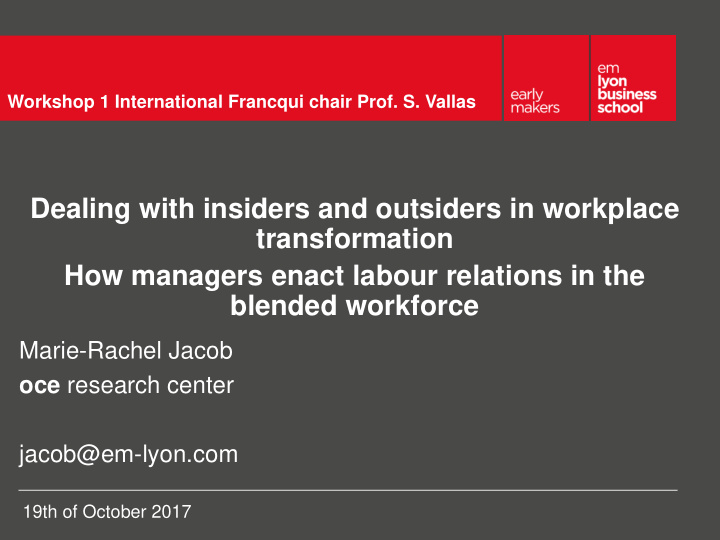



Workshop 1 International Francqui chair Prof. S. Vallas Dealing with insiders and outsiders in workplace transformation How managers enact labour relations in the blended workforce Marie-Rachel Jacob oce research center jacob@em-lyon.com 19th of October 2017
Definitions ▪ Fordist regime of employment (Kalleberg, 2000) ▪ Standard workers have an indefinite full-time employment contract and perform work at their employer’s workplace under direct supervision => social protection and labour relations systems ▪ Nonstandard workers are temporary workers with fixed-term employment contracts, temporary agency workers, contract workers and part-time workers ▪ Post-Fordist/Flexible regime of employment ▪ Permanent workers and organizational insiders => permanent employees ▪ Temporary workers and organizational outsiders => external workers ▪ Blended workforce ▪ mixing permanent employees with external workers (Ashford et al., 2007)
Theoretical Background • Consequences of the blending for permanent employees (Davis-Blake et al. 2003; Broschak et al. 2006) Managerial issues and nonstandard workers (George & Ng 2011) of the blended • Importance of perceived mobility (George et al. 2012) workforce • Managerial strategies & power relations with nonstandard workers (Smith, 2001; Olsen, 2006) • Workplace transformation as a relational phenomenon (Vallas 2003a,b;2006) Workplace • Unions’ difficulties with teamwork (Pulignano, 2002) transformation & and action at a broader level than workplace workers ’ (Pulignano, 2017) • Front-line managers manage employment relations participation with permanent employees and external workers (Townsend, 2013) and face blended workforce issues
Methods: in-depth case study ▪ French context ▪ High level of labour regulation ▪ Types of employment contracts ▪ C ontrat à D urée I ndéterminée: indefinite employment contract ▪ C ontrat à D urée D éterminée: fixed-term contract ▪ Apprenticeship contract: student working part-time for a company while achieving education ▪ Temporary agency contract: worker employed with a fixed-term contract by a temporary help agency and placed in a client company’s workplace ▪ Other types of contracts ▪ Contract work: worker employed by a service provider/consultancy company (with a CDI or a CDD) and place in a client company’s workplace ▪ Students having internships with a company ▪ The case: the French headquarters of a large Belgian-French company
Data collection The Facilities Department merged with the Corporate Real Estate Department ▪ 120/180 permanent employees ▪ 30/50 external workers: temporary agency workers, contract workers, students in apprenticeship/internship ▪ Department-level : change process & consulting process of the employees ’ representatives ▪ Team-level : change in members and internal dynamics of four teams ▪ Individual level : individual records, work and informal conversations with both permanent employees and external workers
Findings: 3 mechanisms Improving work and employment conditions for external workers is not related to their employment status (intern/temporary agency worker/contract worker), but rely on 3 mechanisms: Work role and perceived performance of the Work-related external worker in the workplace mechanism Organization- External worker’s embeddedness in the formal related organizational structure mechanism Social-related External worker’s relationship with a sponsor in mechanism the organization
Work-related mechanism Sara, temporary agency worker from 2008 to 2011 Joined the safety and security team to monitor the access control (badges to get into buildings offices) Cleared a chaotic situation and was recognized as very efficient New headquarters were set up and the access controls were out of control: “Seeing as with the work, I handled it well, they gave me another rise so that I could go to [the new headquarters], because they wanted me to be here [ … ] seeing as he’d heard about me, and he was quite happy with the work [ … ] they asked me to come and sort out a bit and save the organization” (excerpt of interview) The manager told the researcher: “We need Sara in the new headquarters”
Organization-related mechanism Cédric, contract worker from 2010 to 2011 Mail signature: Cédric WARZACK – Phone number – Mobile phone number Regine Rhesus – Phone number – Mobile phone number cedric.warzack@external.client-company.com regine.rhesus@client-company.com Name building - 20ème étage – office 20-073-B Name building - 19ème étage – office 19-073-B Providing facilities service (employer’s name) Corporate Real Estate and Logistics Department Corporate Real Estate and Logistics Department His name is included in the team organizational chart and he is a contact for the users in the workplace. “I don’t really know what is the contract between my employer and the department. I don’t know if I need to achieve key performance indicators or just spend time in doing things. I don’t really care about it, I’m fine with the client, I’m happy in this workplace” (excerpt of an informal conversation)
Social-related mechanism Cecilia (2008-2010) and Amanda (2008-2011), two students in apprenticeship with Regine as a tutor. Regine is permanent employee and manager of a team. She made both Cecilia and Amanda be hired as temporary agency workers with the maximum wage-level compared to their educational attainment. She found additional temporary assignements in other teams of the department. => Regine had an informal source of power and once she lost it, this role of sponsor stopped.
Negotiating precarity Serge Paugam’s distinction between ▪ Precarious work ▪ Precarious employment
Recommend
More recommend